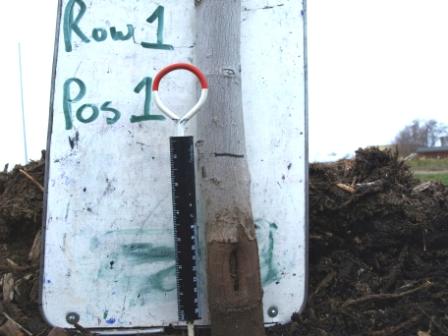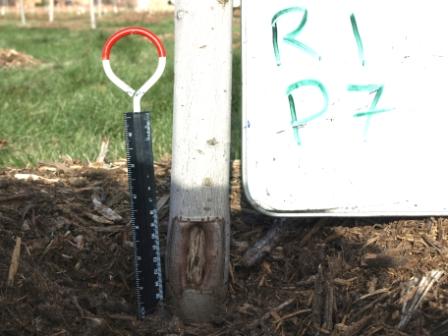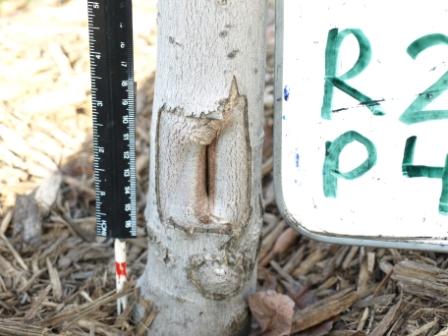After Linda’s post yesterday I just had to add my own 2 cents about gator bags. I use ’em and I like ’em. But, that said, I never allow gator bags to sit against trees for an extended period of time (Maybe 6 weeks when the tree first goes in). That’s just asking for trouble! But looking at those bags got me thinking about a project which we’re finishing up this year. Volcano mulching. Believe me, it sounds a lot cooler than it is. Volcano mulching is when you make a big pile of mulch along a tree’s trunk, as in the picture below.

The reason we’re looking at volcano mulching is that everyone says it’s bad, but no-one has really proven that it’s bad. The reasons that volcano mulching are supposed to be bad are twofold: First, the mulch could cause rot on the tree’s stem (as with those gator bags) and second, because it might be possible for a tree’s roots to grow up into the mulch, potentially surrounding the stem, which might lead to the roots choking the stem as the tree grows larger. Not a good situation. Anyway, early in 2007 we took a field of maples and cut squares in their trunks, as seen below, and then either did or didn’t mound up mulch around these tree’s stems.

What we expected to see was that, over time, the wounding and presence of a mulch volcano would lead to diseases in the stem. Instead what we found is that, for many of the trees, deeper mulch actually led to the wounds closing more rapidly. The image below is of a wound that was covered with mulch.

While this next image is of a wound that wasn’t covered with mulch.

Of course some of the wounds without mulch closed fine as well, as you can see in the next image. (Why isn’t anything ever cut and dried?)

So what does all this mean? Well, nothing yet. Research is a funny thing: it rarely gives you quick and easy answers. I won’t recommend mulch volcanoes because we still haven’t examined those roots that may enter the mulch and surround the stem. And before I say that the volcanoes didn’t affect stem rot in this study I want to take a closer look at those wounds by cross sectioning the tree which we’ll probably do this fall. Plus we’ve got to run statistics on all the different trees….. and then it would be great if someone else would take a stab at this study to confirm what we see…. I tell you what, nothing’s easy.
My take has been that it's an aeration (or lack thereof) issue as well as the bugs/disease thing. After harping on the horror of mulch volcanoes for years to staff and students…I await your results!
I wouldn't be surprised if you're right (perhaps somebody will start to market a "breathable" band-aid for trees?). It's going to be a very fun study to break down — I can't wait to cross-section the stems!
I'd be curious to see what would happen if you used sawdust or compost or some other fine textured mulch. My guess is that a coarse mulch that's well aerated and full of aerobic microbes might act quite differently than a mulch where water and air movement are impeded and where anaerobes might be more active. It's a fascinating study Jeff and I hope you're able to publish it.
What a cool study! The question that spring to mind for me is if healthy trees react as well to this sort of less-aerobic bandaging as wounded trees (or rather, the wounds themselves) do. I've always thought that landscapers (and homeowners imitating what they see) make mulch volcanoes simply to sell more mulch. I tell my contractors that trees don't need scarves or mufflers the way people do. I'm looking forward to seeing your cross-section results.
Some people put up the volcano mulch because they like the look.
I suspect this study can’t be used to make assumptions about the most common volcano mulch uses. But it could be easily extended.
I am thinking healthy new plantings. Not established.
In a sense, your study evaluated volcano mulch vs one “risk” .. And does it help or harm. Other “risks” with new landscaping would benefit from the same test.
Just for example, I would be curious about:
* alll water added very near the trunk for first N years (in an area with little natural water. I am in CO)
* planted too deep
* not enough B&B removed
* survival of a verrrry wet year with not enough runoff
* survival of a dry winter (sometimes easy to forget to irrigate slumbering landscapes)
Another “myth” to consider is whether volcano mulch sheds water away from the root system of newly planted trees. The answer, like so many in our business, is, that it depends.
I’ve also observed mowing patterns throughout a season can shape a well-basined tree mulch into a volcano.
It certainly can if the mulch is a hydrophobic bark. Arborist chips, on the other hand, absorb water.
I wonder if there has been any more research done on volcano mulching?
None that we’re aware of. There’s no evidence, at this point, that it’s harmful to trees.